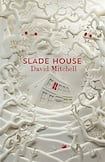
Once upon a time, publicity campaigns for novels involved little more than a few newspaper ads, a regional book tour and, if you were lucky, an interview with one of the broadsheets. Nowadays, marketing has turned digital, with social media crusades beginning before the proofs even go out.
Three years ago, Roddy Doyle's Two Pints became the first work of fiction to be culled from a series of Facebook posts. Last year, to promote his sixth novel, The Bone Clocks, David Mitchell produced a long series of tweets which has led in turn to a new novel, a modern twist on the haunted house genre. What's next, you might ask? JM Coetzee using his holiday Instagram pictures as the basis for a novella? John Banville sorting through his old Snapchats to see whether there might be a story in there somewhere? Anything is possible.
There’s a reason why David Mitchell is the most consistently praised novelist of his generation. His work manages to beguile, impress and delight in equal parts. His books are intricately plotted, mutually interwoven and, as his writing has matured so has his major theme, the question of what happens to the soul after death, whether it somehow inhabits a new consciousness or is simply lost forever. It’s hard to think of a writer in his 40s so concerned with issues of mortality, a subject that is more often the preserve of elder statesmen.
Universe of characters
For 15 years Mitchell has been building a universe of characters that is far more original and interesting than anything comic-book creators could even dream of, allowing his cast to slip in and out of separate works as their histories, aspirations and motivations are further revealed.
For the reader, keeping the separate elements in one's head is no mean feat and I daresay there are PhD students out there who are having a ball drawing intertextual connections but crucially Mitchell never forgets that he's writing fiction, an artistic form designed to engage, entertain and challenge. Despite how clever these books are, there's nothing calculated or cynical about them. In fact, for the most part, and never more so than with Slade House which I read in a single sitting, they are unputdownable.
This is Mitchell's shortest novel, a creepy, unsettling tale that returns us to the world of the Horologists, those time and shape-shifting malevolents who dominated his last book while reintroducing or referencing previous characters such as Dr Marinus and Crispin Hershey, author of Desiccated Embryos – definitely no relation of Martin Amis' Dead Babies.
The basic premise is a simple one: every nine years on the last Saturday of October, a door appears in Slade Alley, leading to a palatial home where the twins Jonah and Norah Grayer hold court in various disguises, looking for a new victim in their quest for immortality. There are five chapters set between 1979 and 2015, each with a different narrator, and as the eras change so does the tone and the representations of outsiders that dominate the story.
Children, traffic wardens, lesbians, the overweight, the permanently ignored slip in and out of the pages and the Grayers, in their pursuit of power, make a point of seeking out those whose absence from society might be less mourned.
His characterisation of a recently-divorced policeman whose anger towards women conflicts with his growing affection for the wealthy but mysterious Chloe Chetwynd is both funny and unnerving while the creation of a paranormal society that investigates his disappearance offers a depiction of a lonely young girl whose surprise at finding that the object of her affection holds similar feelings for her leads to a heartbreaking conclusion.
The elements of science fiction that prevail towards the end of the novel are present in The Bone Clocks and, to a lesser extent, in Cloud Atlas and the interconnected narratives of Mitchell's debut novel Ghostwritten while the social awkwardness of Sally Timms recalls that of the stammering Jason Taylor from Black Swan Green, Mitchell's most conventional, personal and (for me) powerful work.
And if there are moments when the text seems too littered by orisuns, Atemporals, Horologists, lacunas and the Ninevite Candle, leaving the reader feeling a little boggled, well that’s what happens when you enter the weird and wonderful world of Clonakilty’s finest. Keep up, the narrative insists as the action becomes increasingly fast-paced. Keep up or get left behind.
One of the most dominant themes of Slade House is the notion of grief versus hope. Inventive and provocative sentences abound when a missing person's sister remarks that she envies "the weeping parents of the definitely dead you see on TV. Grief is an amputation, but hope is incurable haemophilia: you bleed and bleed and bleed". Similarly, the twins' insatiable need to stay alive at the expense of whatever unlucky person happens to cross their paths speaks to selfishness and the contemporary greed for power.
Slade House might be viewed by some as a lesser work in the Mitchell catalogue and the fact that it is being published without the fanfare that generally surrounds his books suggests that it is simply a postscript to the magnificent The Bone Clocks. But I suspect that it will eventually be an integral part of the author's bibliography, bustling as it is with characters who are likely to reappear in one incarnation or another in the future.
As a standalone piece of work, however, it remains a highly effective, creepy and witty ghost story, designed to unsettle the reader and raise questions about what all of us might do in our quest for immortality. As it turns out, Twitter can be used for more than just telling the world what you ate for breakfast.
John Boyne's latest novel is The Boy at the Top of the Mountain (Doubleday)















